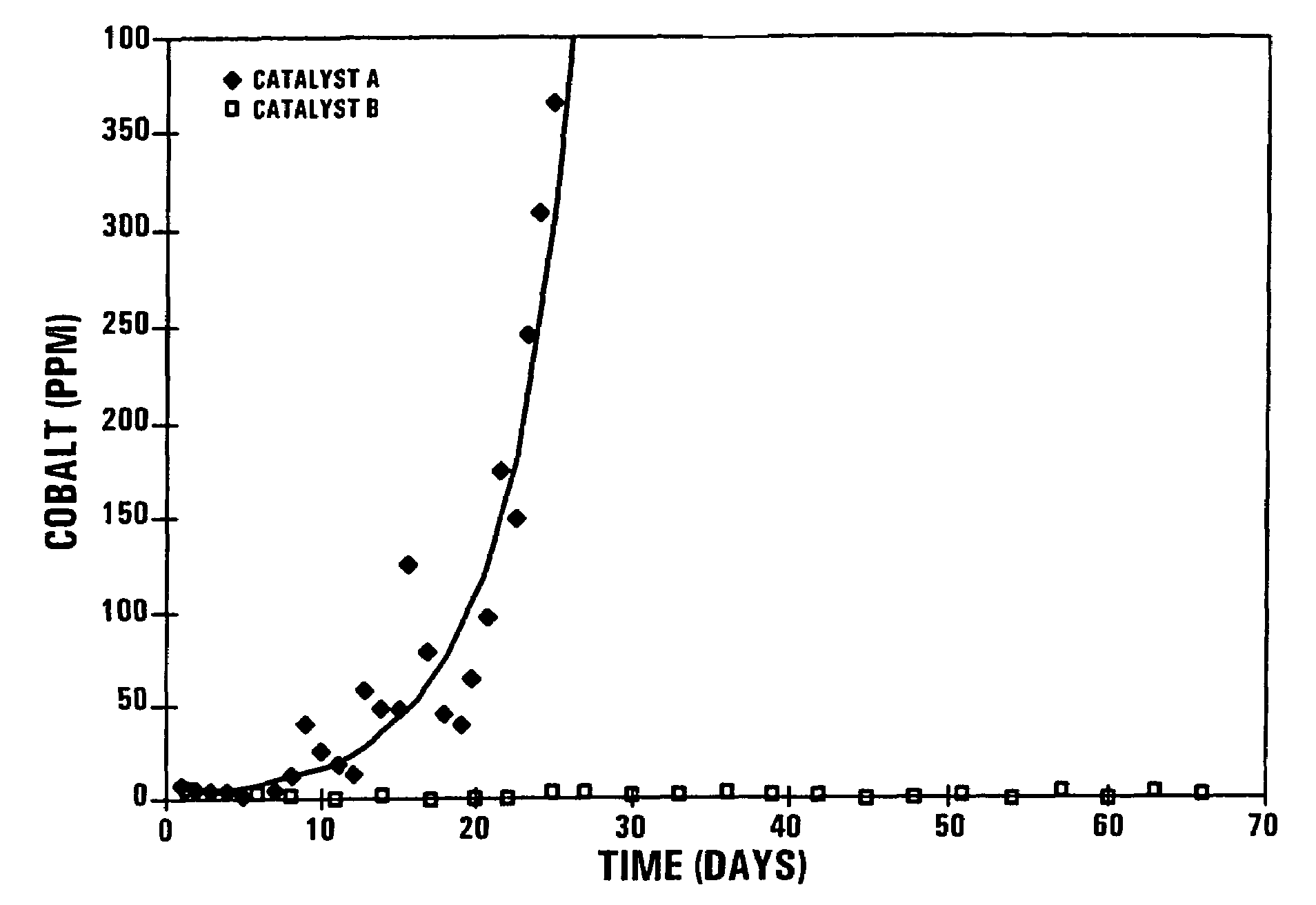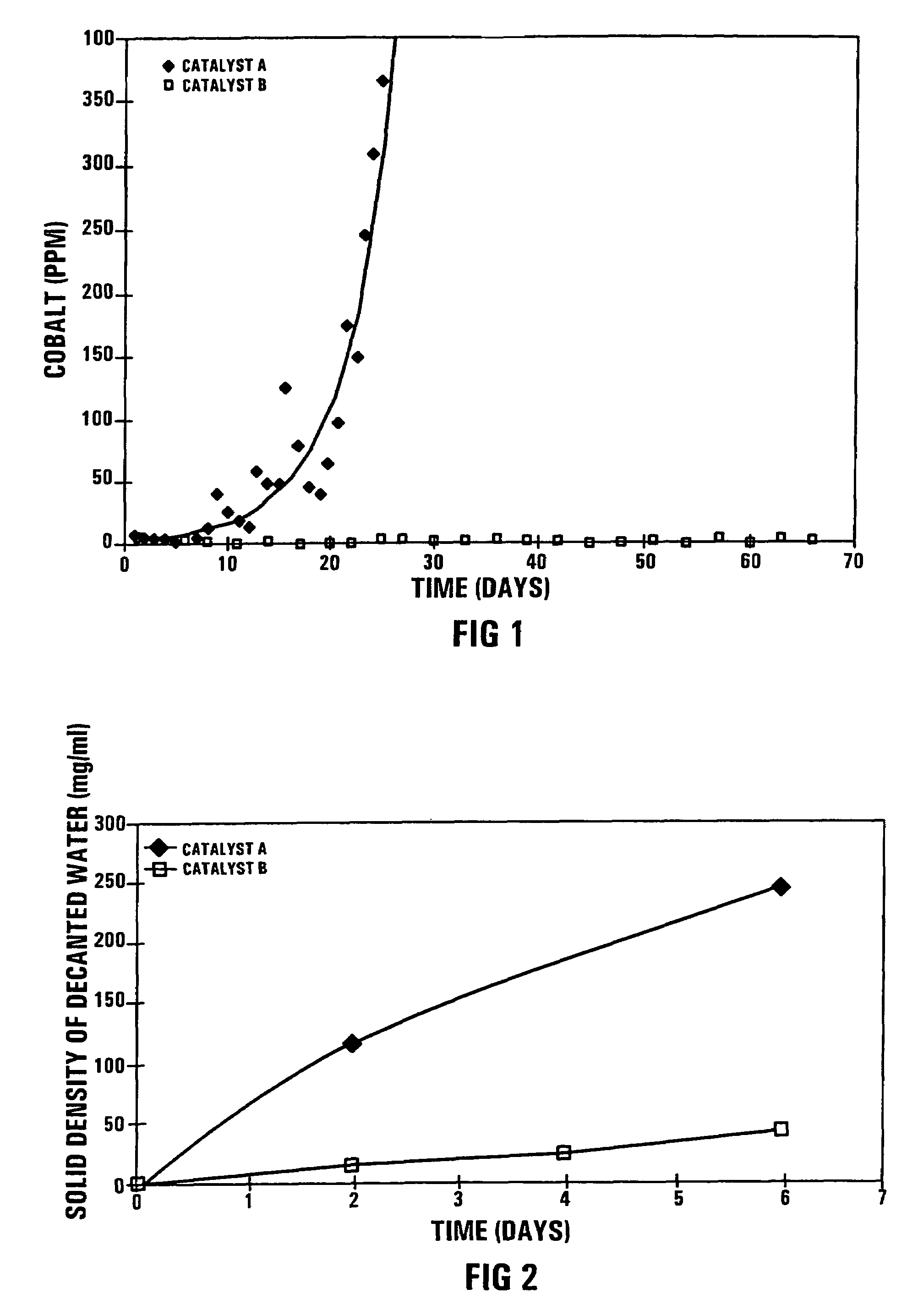Catalysts
a catalyst and catalyst technology, applied in the field of catalysts, can solve the problems of contaminated wax products with ultra-fine cobalt rich particulates, and the synthesis catalyst of fischer-tropsch is susceptible to hydrothermal attack, and achieve the effect of reducing the catalyst precursor
- Summary
- Abstract
- Description
- Claims
- Application Information
AI Technical Summary
Benefits of technology
Problems solved by technology
Method used
Image
Examples
example 2
Preparation of Modified Catalyst Precursor B
[0044]A cobalt catalyst precursor was prepared in a similar manner to catalyst precursor A, and subsequently modified with silica, to obtain a modified catalyst precursor B. An impregnation method was used to achieve the modification. Thus, silicon, in the form of TEOS (tetra ethoxy silane, 2,5 kg) as precursor, was added to 20 L ethanol at 60° C. Ethanol was thus used as the impregnation solvent. 20 kg of catalyst precursor A of Example 1, was added to this solution, which was then kept at 50° C.-75° C. for 1 hour. Subsequently, the solvent was removed under vacuum at 0.03-0.2 bar(a), with a jacket temperature of the drier equipment of 95° C. The drying step was terminated after 2 hours, and the resultant dried impregnated support was loaded immediately into a fluidized bed calciner. The loading took about 1 to 2 minutes, and the temperature remained at its set point of about 75° C. The temperature of the fluidized bed was increased at a ...
example 3
Laboratory Slurry Phase Fischer-Tropsch Synthesis
[0045]Cobalt catalyst precursors (modified or unmodified) were reduced prior to Fischer-Tropsch synthesis in a tubular reactor at a hydrogen space velocity of 200 mln hydrogen / g catalyst / h and atmospheric pressure. The temperature was increased to 425° C. at 1° C. / min, after which isothermal conditions were maintained for 16 hours. Comparative Catalyst A was thus obtained from catalyst precursor A, while Catalyst B was thus obtained from modified catalyst precursor B.
[0046]Between 10 g and 30 g of the resultant reduced catalyst, ranging between 38 μm to 150 μm, was suspended in 300 ml molten wax and loaded in a CSTR with an internal volume of 500 ml. The feed gas consisted of hydrogen and carbon monoxide in a H2 / CO molar ratio from 1.5 / l to 2.3 / l. This reactor was electrically heated and sufficiently high stirrer speeds were employed so as to eliminate any gas-liquid mass transfer limitations. The feed flow was controlled by means of ...
example 4
Pilot Plant Fischer-Tropsch Synthesis Tests
[0051]During a confidential Pilot Plant Fischer-Tropsch synthesis test run, using 5 kg of the catalyst A in a 11 m high bubble column reactor with an external recycle, the secondary filtered wax product turned grey after about 10 days on-line and the cobalt content increased to 350 mass ppm after 25 days on line, as shown in FIG. 1. The secondary filtered wax product is defined as the wax product produced in the Fischer-Tropsch synthesis test run and which has been subjected to a primary solids separation step, and thereafter to secondary ex-situ filtration through Whatmans 42 (trademark) filter paper.
[0052]The test run was performed under realistic Fischer-Tropsch synthesis conditions:
[0053]
Reactor temperature:230° C.Reactor pressure:20 Bar% (H2 + CO) conversion:50-80%Feed gas composition:H2:ca 50 vol %CO:ca 25 vol %Balance:Ar, N2, CH4 and or CO2
[0054]The pilot plant test run was repeated with Catalyst B, using an identical quantity of Cat...
PUM
| Property | Measurement | Unit |
|---|---|---|
| pore diameter | aaaaa | aaaaa |
| pore diameter | aaaaa | aaaaa |
| pore diameter | aaaaa | aaaaa |
Abstract
Description
Claims
Application Information
 Login to View More
Login to View More - R&D
- Intellectual Property
- Life Sciences
- Materials
- Tech Scout
- Unparalleled Data Quality
- Higher Quality Content
- 60% Fewer Hallucinations
Browse by: Latest US Patents, China's latest patents, Technical Efficacy Thesaurus, Application Domain, Technology Topic, Popular Technical Reports.
© 2025 PatSnap. All rights reserved.Legal|Privacy policy|Modern Slavery Act Transparency Statement|Sitemap|About US| Contact US: help@patsnap.com


